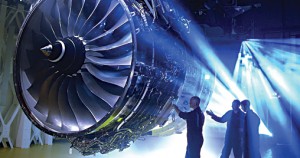 Purdue is not only a steady source of skilled employees for Rolls-Royce, but also a partner in research and education.
Purdue is not only a steady source of skilled employees for Rolls-Royce, but also a partner in research and education.
Among the University’s numerous alliances with industry is the Product Lifecycle Management (PLM) Center, which fuses resources from the colleges of Technology, Engineering and Science to provide companies with tools and 0processes to help them develop, manage and support their products.
According to Nathan Hartman, associate professor of computer graphics technology and the center’s co-director, Purdue’s early work with Rolls-Royce coincided with the company’s initial deployment of PLM processes, including data migration and geometry automation techniques, the configuration of tools for computer-aided process planning and the conversion of 2D manufacturing tooling drawings to 3D models.
Those efforts have continued over ensuing years, Hartman says, all with the goal of making the Rolls-Royce user community more efficient, consistent and productive. One example is the airfoil seed generator (ASG), a Purdue-created software utility that allows a product modeler to create a variety of different blade models for turbine engines.
“Historically, this would take anywhere from 14 to 20 hours per blade model,” he says. “That time was reduced to between 5 and 10 minutes with the use of the ASG, resulting in substantial cost reductions for Rolls-Royce as the technology became integrated into the airfoil design process.”
The center’s work with Rolls-Royce and its other industry partners is equally beneficial to Purdue and the College of Technology, Hartman says.
“It engages students and faculty with meaningful problems to solve involving the design, manufacturing and support of real products, as well as the role technology plays in those processes. It also helps companies like Rolls-Royce to make better products, which in turn impacts their relationship with customers.”
